When it comes to cosmetic products, few people think about how profound the effect of the numerous ingredients listed on the labels of everyone's favorite jars and tubes can be. The cosmetics industry uses thousands of synthetic substances to create popular beauty and hygiene products - from lipstick and all kinds of lotions to shampoo and shaving cream.
Many of these chemicals are also used extensively in manufacturing processes for cleaning equipment and machines, controlling pesticides, and lubricating engines. Most cosmetics consumers will agree: a substance that can easily scrub a garage floor is not suitable for cleansing facial skin.
In many countries (including the US), there are huge gaps in federal legislation, allowing the cosmetics industry to include virtually any ingredient in makeup and hygiene products - even those traditionally associated with dangers such as cancer, infertility or intrauterine developmental disorders. Along with the introduction of hundreds of untested chemicals into cosmetics and perfumes, breast cancer rates have skyrocketed.
Perhaps it's time to check the ingredients on your shelves and find out if using your favorite products poses any real health risks. Potentially harmful chemicals can be divided into the following groups.
Phthalates
Phthalates, or phthalic acid esters, are a group of substances that have the potential to disrupt the normal functioning of the endocrine system. Traditionally, these chemicals are found in products such as nail polishes and synthetic perfume(here perfume means not only Eau de Toilette, but also any perfume compositions in various cosmetic products). Such chemicals in cosmetics lead to early puberty in girls, and there is evidence of a connection between exposure to phthalates and the development of breast cancer in adulthood. Some phthalic acid esters acquire the properties of weak estrogens in cell culture systems.
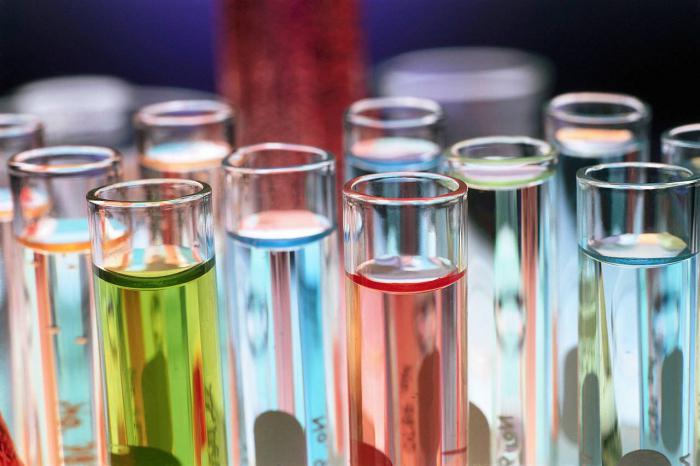
Triclosan
Triclosan is used in the production of antibacterial soaps, deodorants and toothpaste. Its purpose is to limit the growth of bacteria and mold in the final product. This chemical is classified as a pesticide and can disrupt the basic functions of the endocrine system. It is most often noted Negative influence for hormones thyroid gland regulating metabolism (metabolism). Such chemistry in cosmetics can negatively affect consumer health in another way: frequent use of triclosan increases bacterial resistance to antimicrobial drugs.
1,4-dioxane
1,4-dioxane is never listed on cosmetic product labels. It is a contaminant (pollutant) released by gasoline during the production of shampoos, shower gels, baby bath products and other foaming products. The International Agency for Research on Cancer has included 1,4-dioxane in its list of potential carcinogens.
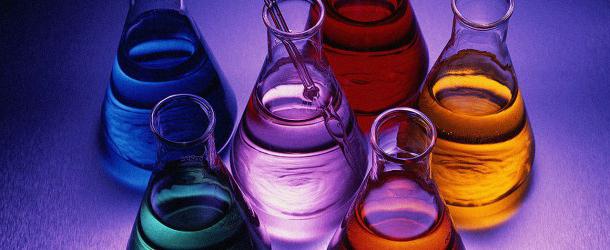
Parabens
Chemistry in cosmetics is often used to prevent the spread of fungus and microbes in finished formulations of creams, lotions, ointments and roll-on deodorants. For these purposes, parabens are also used, which, among other things, are preservatives. Parabens are completely absorbed by the skin and are found in samples of biomaterials removed by biopsy from breast tumors. Some researchers, however, argue that the connection between these chemicals and the development of cancer has not been proven.
Although the skin does absorb parabens, they are almost completely eliminated from the body through the kidneys. This means not only that the body, using its own resources, gets rid of toxins, but also that the chemicals travel a long way through the genitourinary organs, and thereby have a negative effect on the entire body. Exposure to parabens has been linked to food allergic reactions, increased levels of stress hormones in pregnant women and newborns (in whom, by the way, parabens are detected in the first portion of urine) and damage to sperm at the DNA level.
Moreover: not all chemicals in this class are excreted through urine. A certain amount remains in the blood plasma and can withstand a temperature high enough for parabens (37 degrees) for 30 days. These substances are also characterized by estrogenic activity and thereby provoke the development of cellular abnormalities.
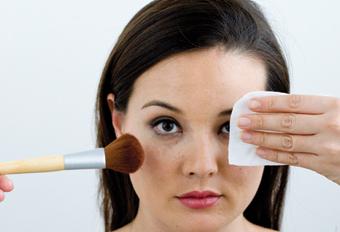
Almost any cosmetics (see photo above) contains parabens - just read the labels on the packaging.
Ethylene oxide (ethylene oxide)
Ethylene oxide is widely used to sterilize surgical instruments. It can also be a contaminant in personal care products such as shampoos and shower gels, since this substance is used to soften some foaming formulations and is not completely removed from cosmetics. Ethylene oxide is classified as a known carcinogen causing cancer in humans. In addition, it is on the list of chemicals linked to the development of mammary gland cancer in animals.
1,3-butadiene
Popular cosmetics companies actively use 1,3-butadiene in the production of shaving creams, sunscreen sprays and foundation creams. In addition, this contaminant may be found in the composition of medicinal antifungal drugs. This substance is especially dangerous if it enters the body through inhalation. The carcinogen 1,3-butadiene causes mammary cancer in rodents.
![]()
Polycyclic (PAH)
Polycyclic aromatic hydrocarbons (PAHs) are a group of substances found naturally in coal, crude oil and other combustible materials. Everyone knows such a PAH as naphthalene. Decorative cosmetics (photo in the article) and shampoos are often made using coal tar - such products may contain PAHs. Polycyclic aromatic hydrocarbons are potential carcinogens.
Placenta extract
This extract is made from human or animal placenta and is found in hair conditioners, shampoos and a variety of styling products. Most of these products (by the way, far from being the most best cosmetics) is supplied to developing countries. Research has revealed the presence of progesterone in the placenta extract, a steroid hormone and contaminant recognized as a potential carcinogen.
Lead
Lead is a contaminant in more than 650 various means makeup and personal hygiene. It is found in sunscreens and lotions, nail polishes, lipsticks, whitening toothpaste. It has been proven that lead is a neurotoxin that can cause speech and behavior disorders. There are studies that identify lead exposure as one of the causes of miscarriages, decreased fertility (in both women and men), and delayed puberty in girls.
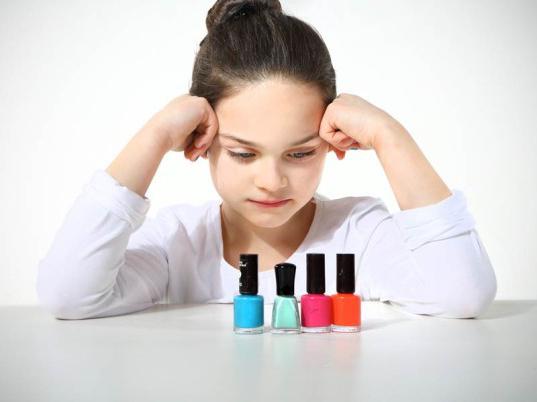
Sunscreens
Even the best cosmetics with sunscreens contain chemicals that have significant estrogenic activity. In vitro studies have confirmed that with regular use sunscreen Cancer cells gain longer lifespan. Chemicals that provide UV protection actually pose a danger to humans and animals alike.
Flavors (fragrances)
Fragrances (aka fragrances) are synthetic components of most cosmetics. Their main purpose is to give the compositions a pleasant smell. However, the composition of the fragrance itself is not available to the mass consumer: fragrance recipes have the status of a trade secret. This means that cosmetics companies are not at all obliged to disclose the secret of aromatic ingredients in their products: you can simply add the term “perfume composition”, “fragrance”, “flavoring substance”, etc. to the list of components, and regulatory organizations will consider the composition of the product sufficient . Unfortunately, most fragrances contain phthalates (see above) and synthetic musk, which is potential danger for the defense mechanisms of the immune system.
Synthetic musk in fragrances disrupts the ability of cells to independently cleanse themselves of toxins and leads to their poisoning by those toxins that are normal conditions are promptly removed from the body. Residual amounts of musk are found in drinking water, blood and breast milk. In addition, most secret ingredients in perfume compositions are strong allergens.
Why are chemicals so dangerous?
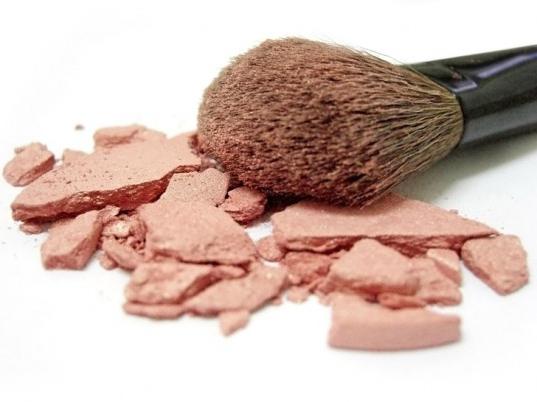
Most consumers are aware of how dangerous chemicals in cosmetics are. Interesting Facts: connoisseurs of all kinds of makeup and personal care products simply prefer gigantic lists of ingredients in their favorite creams and lotions, or they deliberately downplay their own risk, believing that time-tested manufacturers will not add real ingredients to their products. Such consumers forget about the three main negative properties chemicals:
- The role of chemistry in cosmetics can be positive (for example, increasing the shelf life of a product), but synthetic substances almost never benefit the body. In addition, they inevitably accumulate in the blood and internal organs. While some toxins come out through urine or sweat, some harmful substances remain inside.
- Organic chemistry in cosmetics does not mean the final product is harmless. Add to this fact the regular use of makeup and personal hygiene products. Soap, toothpaste, shampoo, shower gel, body lotion and face cream are used by many people every day. Sometimes it's not far full list constantly used cosmetics.
- Chemicals have properties that are found external manifestation. Thus, some substances increase the resistance of bacteria to antimicrobial drugs, others accumulate in the environment as a result of human use, and others lead to fetal development defects in pregnant women.
A good solution to the problem is natural cosmetics. Reviews of homemade creams, consisting exclusively of natural oils and other beneficial ingredients, overshadow any advantages of cosmetics industrial production. They really contribute effective cleansing, moisturize and nourish the skin, improve its tone and overall tone, even out and hide imperfections, and prevent the appearance of acne. The only thing left to do is choose something that will not harm the body.
Presentation on the topic: Chemistry and cosmetics
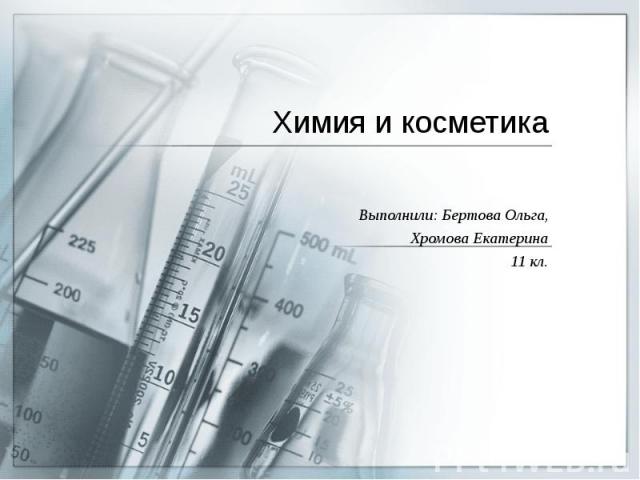
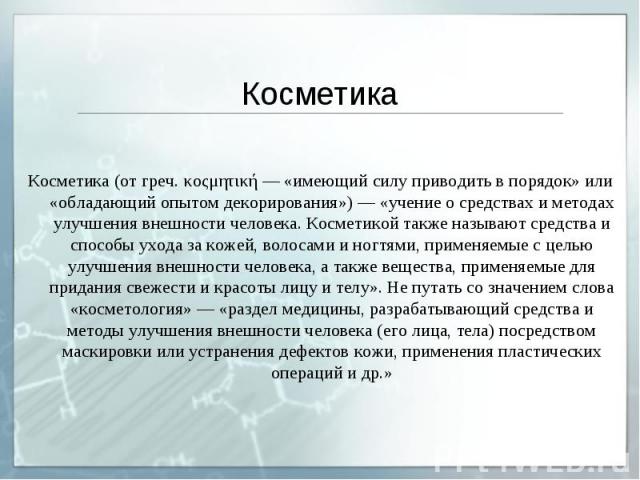
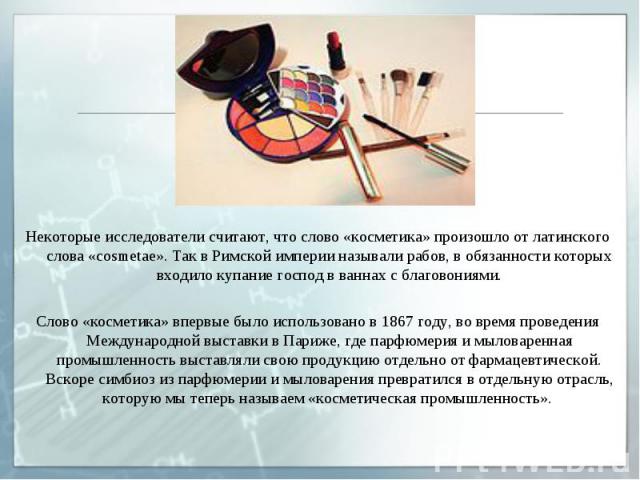
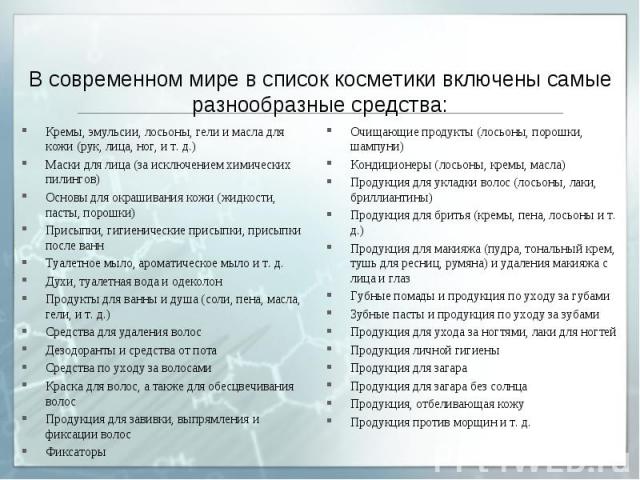
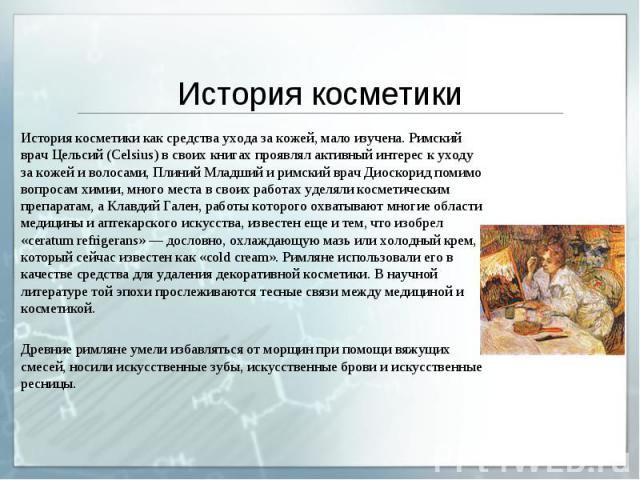
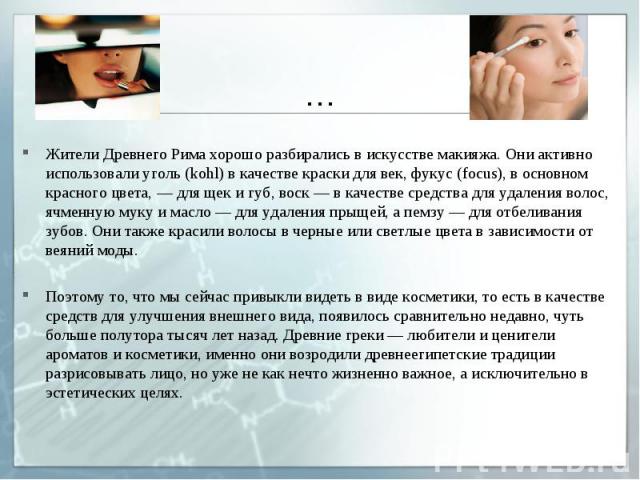


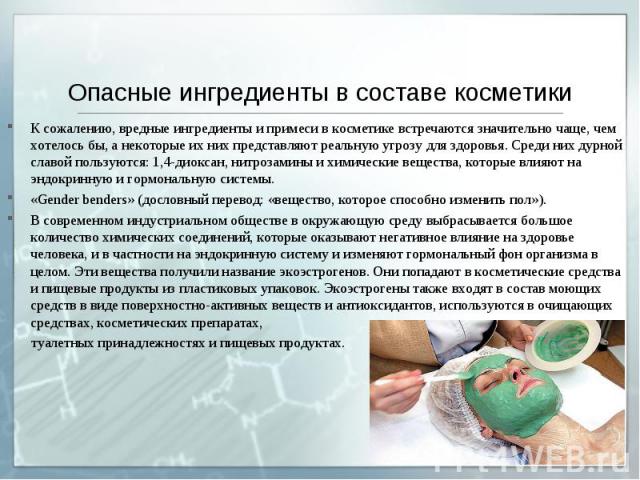
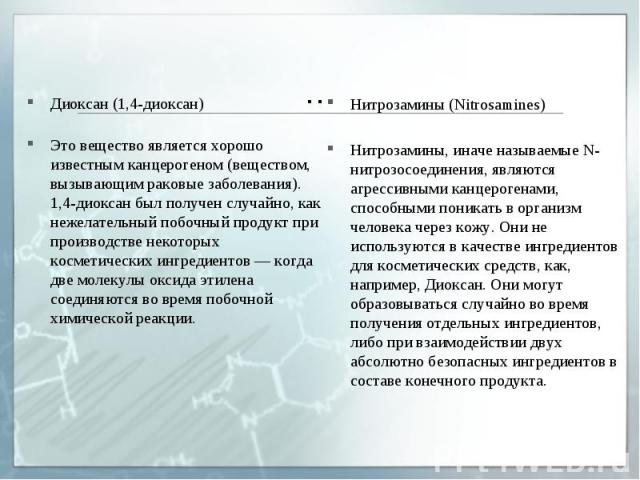
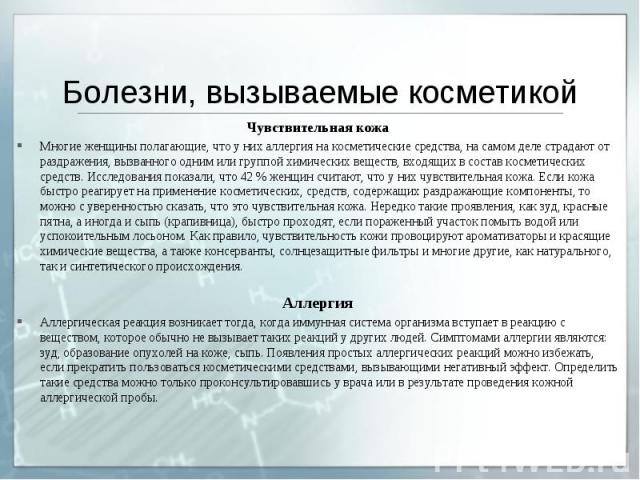
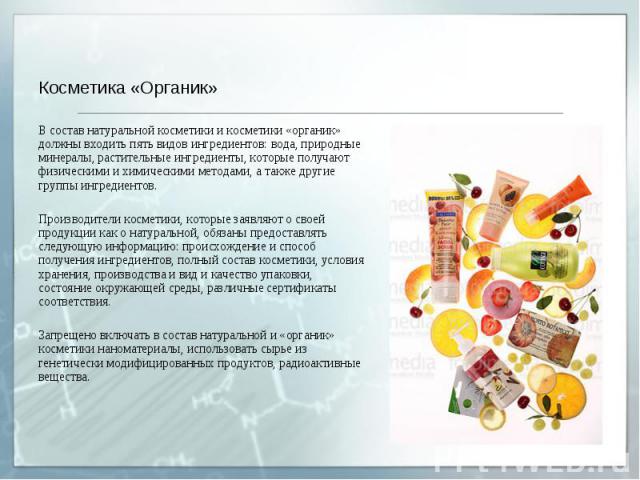
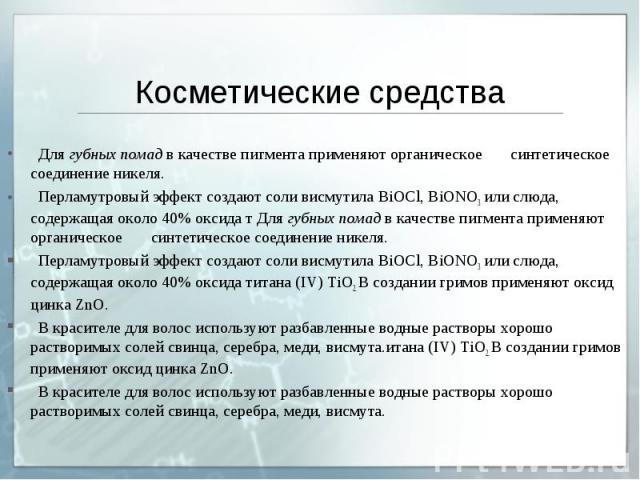
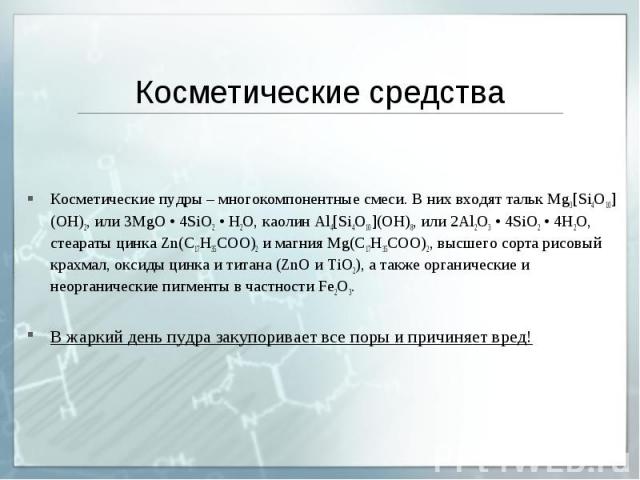
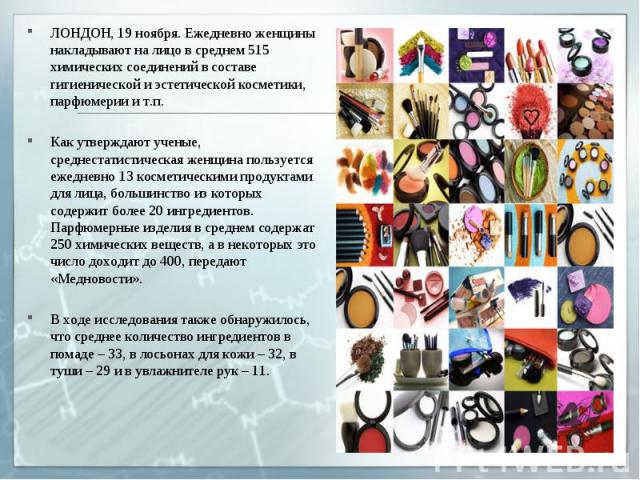
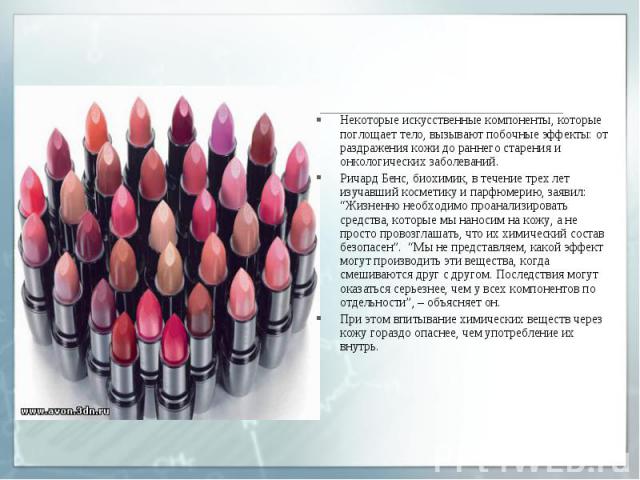
1 of 16
Presentation on the topic: Chemistry and cosmetics
Slide no. 1
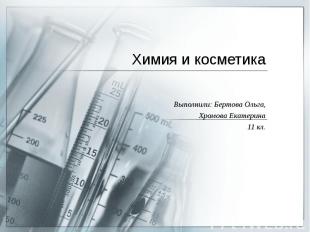
Slide description:
Slide no. 2
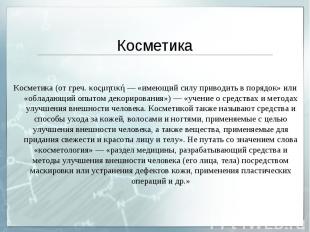
Slide description:
Cosmetics (from the Greek κοςμητική - “having the power to put in order” or “having experience in decorating”) is “the study of means and methods of improving a person’s appearance. Cosmetics are also called products and methods for caring for skin, hair and nails, used to improve a person’s appearance, as well as substances used to give freshness and beauty to the face and body.” Not to be confused with the meaning of the word “cosmetology” - “a branch of medicine that develops means and methods for improving a person’s appearance (his face, body) by masking or eliminating skin defects, using plastic surgery, etc.”
Slide no. 3
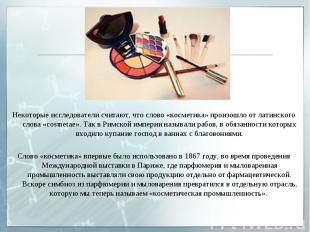
Slide description:
Some researchers believe that the word "cosmetics" comes from the Latin word "cosmetae". This was the name given to slaves in the Roman Empire, whose duties included bathing their masters in baths with incense. The word “cosmetics” was first used in 1867, during the International Exhibition in Paris, where the perfumery and soap industry exhibited their products separately from pharmaceuticals. Soon the symbiosis of perfumery and soap making turned into a separate industry, which we now call the “cosmetic industry.”
Slide no. 4
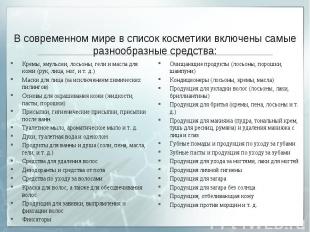
Slide description:
IN modern world the list of cosmetics includes the most various means: Creams, emulsions, lotions, gels and oils for the skin (hands, face, legs, etc.) Face masks (except chemical peels) Skin coloring bases (liquids, pastes, powders) Powders, hygienic powders, powders after baths Toilet soap, aromatic soap, etc. Perfume, eau de toilette and cologne Products for bath and shower (salts, foam, oils, gels, etc.) Hair removal products Deodorants and antiperspirants Hair care products Dye hair, as well as for hair bleaching Products for curling, straightening and fixing hair Fixatives Cleansing products (lotions, powders, shampoos) Conditioners (lotions, creams, oils) Hair styling products (lotions, varnishes, brilliantines) Shaving products (creams, foam, lotions, etc.) Make-up products (powder, Foundation, mascara, blush) and makeup removal for the face and eyesLipsticks and lip care productsToothpastes and dental care productsNail care products, nail polishesPersonal care productsTanning productsSunless tanning productsSkin whitening productsAnti-wrinkle and etc.
Slide no. 5
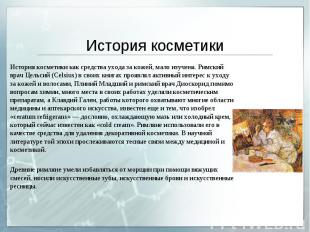
Slide description:
The history of cosmetics as a skin care product has been little studied. The Roman physician Celsius showed an active interest in skin and hair care in his books, Pliny the Younger and the Roman physician Dioscorides, in addition to chemistry, devoted a lot of space in their works to cosmetic preparations, and Claudius Galen, whose works covered many areas of medicine and pharmacy art, is also known for having invented “ceratum refrigerans” - literally, a cooling ointment or cold cream, which is now known as "cold cream". The Romans used it as a remover decorative cosmetics. The scientific literature of that era shows close connections between medicine and cosmetics. The ancient Romans knew how to get rid of wrinkles with the help of astringent mixtures, wore artificial teeth, artificial eyebrows and artificial eyelashes.
Slide no. 6
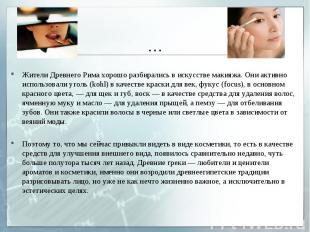
Slide description:
The inhabitants of Ancient Rome were well versed in the art of makeup. They extensively used charcoal (kohl) as eyelid dye, fucus (focus), mostly red in color, for cheeks and lips, wax as a hair remover, barley flour and oil for removing pimples, and pumice for... for teeth whitening. They also dyed their hair black or light colors depending on fashion trends. Therefore, what we are now accustomed to seeing in the form of cosmetics, that is, as means to improve appearance, appeared relatively recently, a little more than one and a half thousand years ago. The ancient Greeks were lovers and connoisseurs of fragrances and cosmetics; it was they who revived the ancient Egyptian traditions of painting the face, but not as something vitally important, but solely for aesthetic purposes.
Slide no. 7
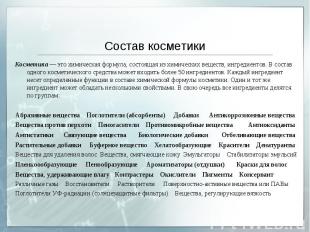
Slide description:
Composition of cosmetics Cosmetics is a chemical formula consisting of chemicals and ingredients. One cosmetic product may contain more than 50 ingredients. Each ingredient has specific functions as part of the chemical formula of cosmetics. The same ingredient can have several properties. In turn, all ingredients are divided into groups: Abrasive substances Absorbers (absorbents) Additives Anticorrosive substances Anti-dandruff substances Defoamers Antimicrobial substances Antioxidants Antistatics Binders Biological additives Bleaching substances Herbal additives Buffer substance Chelating dyes Denaturants Hair removal substances Substances skin softening Emulsifiers Emulsion stabilizers Film formers Foam formers Fragrances (fragrances) Hair dyes Substances that retain moisture Contrasts Oxidizers Pigments Preservative Various gases Reducing agents Solvents Surfactants or surfactants UV radiation absorbers (sun filters) Substances that regulate viscosity
Slide no. 8

Slide description:
When drawing up the chemical formula of cosmetics, many aspects are taken into account: it must attract buyers with its aroma and consistency, be convenient and easy to use, and most importantly - fulfill its main purpose - to improve appearance, give freshness and beauty to the face, body, hair, nails, etc. d. To comply with all requirements, in chemical formula they add many substances that are not related to its main purpose - caring for the appearance. Preservatives serve to ensure that cosmetics retain their presentation for as long as possible: they do not delaminate, do not lose consistency, do not change color or smell. The main purpose of preservatives is to prevent the growth of harmful microorganisms that can lead to various diseases. If a cosmetic contains water and fat, two preservatives are usually added to such cosmetics - to protect the water part and to protect the fatty part of the cosmetic. Only in Russia do they continue to use the toxic carcinogen Bronopol and its derivatives as a preservative. Moreover, it is even added to cosmetics for children.
Slide no. 9
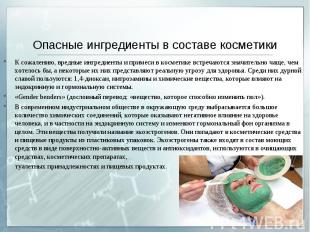
Slide description:
Unfortunately, harmful ingredients and impurities in cosmetics are much more common than we would like, and some of them pose a real threat to health. Among them, the most notorious are: 1,4-dioxane, nitrosamines and chemical substances, which affect the endocrine and hormonal systems. “Gender benders” (literal translation: “a substance that can change gender”). In modern industrial society, it is released into the environment a large number of chemical compounds, which have a negative impact on human health, and in particular on endocrine system and change the hormonal background of the body as a whole. These substances are called ecoestrogens. They get into cosmetical tools and food products from plastic packaging. Ecoestrogens are also found in detergents as surfactants and antioxidants and are used in cleansers, cosmetics, toiletries and foods.
Slide no. 10
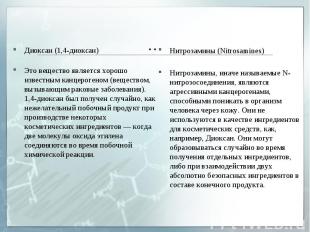
Slide description:
Dioxane (1,4-dioxane) This substance is a well-known carcinogen (a substance that causes cancer). 1,4-dioxane was created accidentally as an unwanted by-product in the production of certain cosmetic ingredients - when two molecules of ethylene oxide combine during a by-product chemical reaction. Nitrosamines Nitrosamines, otherwise called N-nitroso compounds, are aggressive carcinogens that can enter the human body through the skin. They are not used as ingredients in cosmetics, such as Dioxane. They can form accidentally during the preparation of individual ingredients, or through the interaction of two completely safe ingredients in the final product.
Slide no. 11
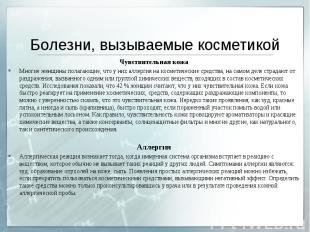
Slide description:
Sensitive Skin Many women who think they are allergic to cosmetics are actually suffering from irritation caused by one or a group of chemicals in cosmetics. Research has shown that 42% of women believe they have sensitive skin. If the skin reacts quickly to the use of cosmetics containing irritating components, then we can say with confidence that it is sensitive skin. Often, symptoms such as itching, red spots, and sometimes a rash (urticaria) go away quickly if the affected area is washed with water or a soothing lotion. As a rule, skin sensitivity is provoked by fragrances and coloring chemicals, as well as preservatives, sunscreens and many others, both natural and synthetic. Allergies An allergic reaction occurs when the immune system the body reacts with a substance that does not normally cause such reactions in other people. Symptoms of allergies are: itching, formation of tumors on the skin, rash. The occurrence of simple allergic reactions can be avoided if you stop using cosmetics that cause negative effect. Such drugs can only be determined by consulting a doctor or by conducting an allergy skin test.
Slide no. 12
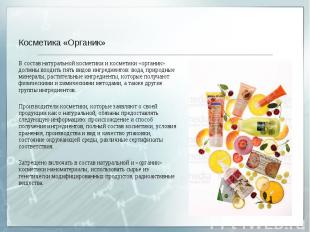
Slide description:
Cosmetics "Organic" Ingredients natural cosmetics and “organic” cosmetics must contain five types of ingredients: water, natural minerals, plant ingredients that are obtained by physical and chemical methods, as well as other groups of ingredients. Cosmetics manufacturers who claim their products as natural are required to provide the following information: origin and the method of obtaining ingredients, the full composition of cosmetics, storage conditions, production and type and quality of packaging, the state of the environment, various certificates of conformity. It is prohibited to include nanomaterials in natural and “organic” cosmetics, to use raw materials from genetically modified products, or radioactive substances.
Slide no. 13
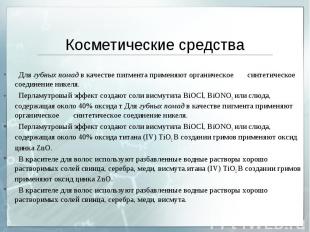
Slide description:
For lipsticks, an organic synthetic nickel compound is used as a pigment. The pearlescent effect is created by bismuthyl salts BiOCl, BiONO3 or mica containing about 40% oxide. For lipsticks, an organic synthetic nickel compound is used as a pigment. The pearlescent effect is created by bismuthyl salts BiOCl, BiONO3 or mica containing about 40% titanium oxide (IV) TiO2. Zinc oxide ZnO is used to create makeup. Hair dye uses diluted aqueous solutions of highly soluble salts of lead, silver, copper, bismuth, titanium (IV) TiO2. Zinc oxide ZnO is used to create makeup. Hair dye uses diluted aqueous solutions of highly soluble salts of lead, silver, copper, and bismuth.
Slide description:
LONDON, November 19. Every day, women apply an average of 515 chemical compounds to their faces in hygiene and hygiene products. aesthetic cosmetics, perfumes, etc. According to scientists, the average woman uses 13 cosmetic products for the face, most of which contain more than 20 ingredients. Perfume products on average contain 250 chemicals, and in some this number reaches 400, Mednovosti reports. The study also found that the average number of ingredients in lipstick is 33, in skin lotions – 32, in mascara – 29 and in the hand moisturizer - 11.
Slide no. 16
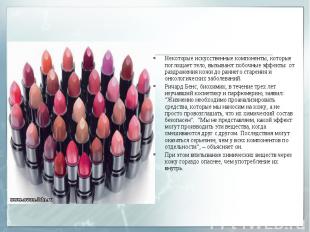
Slide description:
Some artificial ingredients that the body absorbs cause side effects: from skin irritation to early aging and cancer. Richard Bence, a biochemist who spent three years studying cosmetics and perfumery, said: “It is vital to analyze the products we put on our skin, and not just proclaim that they are chemical composition safe." “We have no idea what effect these substances can produce when mixed with each other. The consequences may be more serious than those of all components separately,” he explains. At the same time, absorption of chemicals through the skin is much more dangerous than ingesting them.
“Harmful substances in industry: a reference book for chemists,”
engineers and doctors" in 3 volumes, L: Chemistry, 7th edition, 1976. Excerpts:
“Propylene glycol is part of the main composition of antifreeze (liquid
for cooling car radiators)"; "People working with
mineral oils, numerous skin diseases were identified”;
“In experiments on rats, a lethal dose of sodium lauryl sulfate
amounted to 2.7g.”
This information does not serve as a call to abandon a number of benefits of civilization.You just need to be informed and refuse goods that contain hazardous materials, incl. poisonous ingredients. When I found out how many products on the shelves of our stores were harmful and dangerous to the health of my children and loved ones, to be honest, I became scared. The most offensive thing is that some components are not used in other countries - the same companies produce products with one composition for European countries and another composition for Russia and Ukraine.
A few paragraphs later there is a list of hazardous substances found in cosmetics and detergents. Information has been collected from various sources and summarized.
Why do manufacturers include hazardous substances in their products when there are safer analogues? The first reason is that they use those components that are at least a little cheaper. And if in developed countries that care about consumers, cheap and dangerous components are prohibited, but in our country they are allowed, then for us even “serious” manufacturers do not hesitate to use cheap components. The second reason is that manufacturers often use untested components, without wasting time and money on researching newly invented substances and, moreover, are in no hurry to abandon them even if there are side effects.
Have you ever paid attention to how advertising affects the price and quality of products? Appears on the market new product, it doesn’t matter what it is: chocolate, sausage or cosmetics, it doesn’t matter whether it’s Russian or imported. The product satisfies you in terms of price and quality ratio. Then, if the product begins to be constantly advertised on television, then either the product becomes more expensive or its quality deteriorates, and often, unfortunately, both happen. Often, the quality of the world's widely advertised brands is low - the bulk of the cost of products goes to advertising and expansion of the corporation. For example, ask how much 1 minute of advertising on ORT costs, and now pay attention to how often advertising is done on it toothpaste Colgate, Vanish stain removers, Fructis shampoo and others.
Now suppose, what is the real price of the cost you paid for the product itself, what for the packaging, what for the services of intermediaries, what for advertising? DO NOT believe advertising, do not trust products just because they are sold in a store or even a pharmacy, be sure to read the ingredients, especially for children cosmetic products. Although the composition of washing powders and detergents is no less important!
The actual price of the ingredients in some products may be 2% of the price you paid in the store, but manufacturers are often not willing to give up another 1-2% to use safer raw materials and make higher quality products that are not so dangerous to consumer health.
How to protect yourself as much as possible?
The products of dozens of companies are represented on the Russian market(Russian and foreign) that do not use hazardous substances in their products. Conventionally, these companies can be divided into:
- bioproducers, who use only natural (plant) ingredients in their products that are not hazardous to human health and do not harm the environment;
- eco-producers, which partially use synthetic substances that are considered not hazardous to human health and do not harm the environment.
Bioproducers usually guarantee the quality of their products, the quality of eco-producers(especially those whose products are sold in retail chains, which have recently appeared on the market and are beginning to be actively advertised), Consumers themselves need to be more active - carefully review labels.
Products from bioproducers and eco-producers are sometimes (but not always!) more expensive than most products offered in the supermarket. But the cost of the ingredients from which they are made is much higher. Most likely, this is why some of these manufacturers are network marketing companies(direct sales). In this case, advertising costs are lower, and accordingly the products become cheaper and more accessible to consumers.
Many of these companies produce concentrated products based on plant extracts, which makes their products profitable and convenient.
How to find the “right” manufacturer and the “right” product?
1. First of all, do not try to buy what is available everywhere, what is on everyone’s lips (and more often due to excessive advertising). Do not blindly trust “brands” and “world-famous” manufacturers. Remember that the lion's share of the price of an actively advertised product is made up of advertising costs, which means it is likely that the product belongs to a lower category in terms of price-quality ratio and is only “squeezed” into a more expensive category through advertising. Loud advertising slogans rarely correspond to reality.
2. Read the composition of the goods. At the same time, remember the most dangerous components that need to be excluded.
3. Even for familiar products, sometimes look at the composition- nothing is permanent and manufacturers sometimes fall into the temptation of dubious savings.
4. Sometimes search on the Internet (in the press, at exhibitions) for information about products to increase your own knowledge. Try to find and compare different points of view and draw your own conclusions.
What cosmetics and cleaning products do I and my family use? The answer is different and quite affordable: they are not difficult to buy, and the price is quite affordable for the average buyer. I do not give preference to one or two companies, I’ll name just a few. I like Weleda cosmetics, incl. their children's series. My family uses ROCS toothpastes and sometimes others. I use Amwey concentrated detergents and also “grandmother’s recipes” - sometimes I clean the cups with baking soda. Despite the fact that I have been using the products of these companies for a long time and “trust” these manufacturers, I do not forget to look at the labels. Especially in our country, where the consumer is responsible for himself.
Agrova Anna
May 2009
List of hazardous substances in cosmetics and detergents
(more detailed descriptions see below)
The most dangerous substances that are contained in many detergents and cosmetics, incl. children's
You can remember these names and protect yourself, your children and loved ones.
1.
Sodium lauryl sulfate or sodium lauryl sulfate (Sodium Lauryl Sulfate - SLS, also known as sodium dodecyl sulfate - SDS)
And sodium loreth sulfate or Sodium Laureth Sulfate - SLES -
in shampoos and other cosmetics. Should NOT be contained in children's cosmetics! Especially dangerous for children!
2. Phosphates(eng. phosphate) and anionic surfactants(a-surfactants, surfactants) - in washing powders and other detergents. Avoid detergents containing these substances, as well as those containing chlorine.
3.
Phthalates. Abbreviations: BBP - butyl phenyl phthalate, CDC - American Center for Disease Control and Prevention, CMR - carcinogenic, mutagenic or toxic to offspring, DBP - di(n-butyl) phthalate, DEHP - di-(2-ethylhexyl) phthalate, DEP - diethyl phthalate, DHP - di-n-hexyl phthalate, DIDP - di-zodecyl phthalate) The list is not exhaustive. It’s good if the bottle says “does not contain phthalates.”
Phthalates are odor fixatives in perfumes, as well as in hair products, lotions, and antiperspirants. Particularly dangerous substances, especially for children, pregnant and nursing mothers!
4. Fluoride and sodium fluoride (Fluoride and Sodium Fluoride) - in toothpaste. Should NOT be contained in children's toothpaste! Particularly dangerous for children.
5. Propylene glycol(eng. Propylene Glycol), ethylene glycol(eng. Ethylene glycol) - in creams, lotions, other moisturizers, liquid decorative cosmetics. If it is one of the first in a cosmetic product, this indicates a high concentration!
6. Mineral (technical) oil(eng. mineral oil) - in skin care products and decorative cosmetics. Are used different names: mineral (technical) oil, ceresin, microcrystalline wax, dimethicones, petrolates, petrolatum, paraffin or paraffin oil, propylene glycol (mentioned above).
List of substances that are also hazardous to health and quite common in creams, decorative cosmetics, hair dye, deodorants. And also big advertising canards. Promoted but ineffective ingredients some of them are dangerous to health and appearance.
7. Lanolin(English Lanolin) - in various cosmetics, usually creams (may cause increased skin sensitivity).
8. Triclosan(English Triclosan) chlorophenol - as an antibacterial substance is included in antibacterial soaps, toothpastes, shaving creams and other cosmetics and detergents (destroys both harmful and beneficial bacteria).
9. Parabens(English: Parabene, Parabens), collective name for methylparaben, butylparaben, ethylparabenparabens - used as preservatives in cosmetic products. In deodorants they are used as antimicrobial agents and against sweating (causing dermatitis, allergies, and other consequences).
Currently, most cosmetic products have the inscription “ does not contain formaldehyde and toluene." These carcinogens have also been used as preservatives. Many countries have strict restrictions on their use. In Russia, formaldehyde is officially prohibited in children's cosmetics, children's furniture and building materials intended for interior decoration.
10. Aluminum salts(English: Aluminum..., spelled differently: Aluminum chlorohydrate, Aluminum Sesquichlorohydrate, etc.) - in deodorants and antiperspirants (can cause breast cancer).
11. Methyldibromoglutaronitrile(MDGN) - as a preservative it is included in gels, masks, creams, tanning products, shampoos (often causes an allergic reaction, skin diseases).
12. Loramide Di Lauramide Dea is a semi-synthetic chemical used to form foam and thicken various cosmetic preparations. In addition, it is used in dishwashing detergents due to its ability to remove fats (can dry out hair and skin, causing itching, as well as allergic reactions).
13. Kaolin(eng. Kaolin) - clay white, used in preparations and masks (dehydrates the skin).
14. Bentonite(English: Bentonite) is another ingredient in face masks.
(English: acetylethyltetramethyl-tetralin, AETT) an aromatic dye in hair dye (increases the risk of cancer).
16. Paraphenylenediamine (PPD) is part of many hair dyes (causes allergies and dermatitis).
17. Table salt(eng. Sodium Chloride, Salf, NaCl) - sometimes used to increase the viscosity of cosmetic preparations. In high concentrations it can cause irritation to the skin and mucous membranes of the eyes.
Promoted but ineffective ingredients:
18. Agar-agar Seaweed
19. Albumin(eng. Albumin)
20. Collagen Collagen
21. Hyaluronic acid
(eng. Hualuronic Acid)
22. Tyrosine(eng. Tyrosine)
23
.
Extractsplacenta(eng. Plancental extract)
24. Elastin(eng. Elastin)
Read more about the listed substances.
1.
SLSAndSLES- anionic surfactant (hereinafter referred to as surfactant) amphiphilic substance used to form foam. Among the most hazardous substances in preparations for skin, hair and oral care. No company advertises this substance, even if they use it in their products. Moreover, some companies disguise their products with SLS as natural, stating “derived from coconuts.” Sodium lauryl sulfate is an inexpensive surfactant obtained from coconut oil, effectively removing grease from the surface and highly foaming. Highly foaming detergent in the modern world, this is rather an indicator of low quality, but many “in the old fashioned way” regard abundant foam as an indicator of an expensive high-quality composition. In industry, SLS is used, and was originally developed, for industrial units, cleaning garage floors, used as a car wash, etc.
SLSAndSLEScapable of penetrating and retaining in tissues. Especially dangerous for children! From scientific studies and reports of a number of specialists it follows that these substances are toxic even in small doses and are an active conductor of nitrates. SLES, when reacting with other ingredients, forms dioxins in addition to nitrates. Penetrating through the skin into the body, these substances affect the eyes, brain cells, heart, liver, spleen, and lungs. Getting into the circulatory system and accumulating in cells, they disrupt the process of metabolism and metabolism. Penetrating into the eyes of children, SLS changes the protein composition of eye cells, delays normal development. SLS cleanses by oxidation, leaving an irritating film on the skin and hair. May promote hair loss, dandruff, and affect the hair follicle. The hair dries out, becomes brittle, and splits at the ends. Minimum side effect SLS and SLES - disrupts the protective properties of the skin, increases its sensitivity (dryness, irritation, rashes).
On the websites of some cosmetics manufacturers you can find links to the following information. The expert commission of CIR (an independent organization for assessing the safety of components used in cosmetics) found that Sodium and Ammonium Laureth Sulfates can cause irritation to the eyes and skin. However, based on the available information, the panel concludes that Sodium and Ammonium Laureth Sulfates are safe as currently used in cosmetic products. And to an article published in the Journal of the American College of Toxicology, Volume 2, Number 7, pp. 127-181, 1983 (note the date - 1983!) Sodium lauryl sulfate and Ammonium lauryl sulfate - showed an irritating effect in the window test at concentrations of 2 percent or more. As the concentration increases, the degree of irritation also increases. In products intended for short term use, followed by complete rinsing from the skin surface, Sodium Lauryl Sulfate and Ammonium Lauryl Sulfate show less potential danger. And then the authors of the articles draw the following conclusion:“Sodium lauryl sulfate and ammonium lauryl sulfate are safe in products designed for short-term use, followed by rinsing from the skin surface. In products intended for prolonged contact with skin, the concentration should not exceed 1%.”
What kind of safety can we talk about if SLS and SLES gets into the eyes (especially children, if shampoos without tears are used), and if we use cosmetics with this substance every day and it accumulates in our body?!
2. Anionic surfactants- the most aggressive surfactants, in detergents the permissible content is no more than 2-5% (BUT! try to choose detergents with another surfactant, for example non-ionic). Anionic surfactants are a class of synthetic compounds that dissociate in water to form a surface-active anion (concentrating on the surface, causing a decrease in surface tension). One of the main negative effects of surfactants in the environment is a decrease in surface tension . A- Surfactants can accumulate in organisms in unacceptable concentrations. In humans, they can cause immunity disorders, allergies, damage to the brain, liver, kidneys, and lungs.
Phosphatesenhance the penetration of surfactants through the skin and promote the accumulation of these substances on tissue fibers. Phosphates are salts and esters of phosphoric acids, the main use is phosphorus fertilizers. Phosphates are widely used in synthetic detergents to bind calcium and magnesium ions. Phosphates entering the environment lead to eutrophication of water bodies (the rapid development of algae). The use of phosphates in washing powders is prohibited in many countries for more than 10-20 years. A ban on the use of phosphates has been discussed in EU countries since 2011.
3. Phthalates- these are salts and esters of phthalic (orthophthalic) acid. They are used as plasticizers for plastics, synthetic rubbers, and in perfumery - as solvents and odor fixatives. There is sufficient information about the toxicity and danger of o-phthalic acid esters. Dioctyl phthalate is classified as a possible human carcinogen by the International Agency for Research on Cancer (IARC).
Phthalates are a group of chemicals that have been linked to reproductive harm. Phthalates should be avoided by pregnant and nursing mothers and all women planning to become pregnant. EWG (Environmental Working Group) experts found that this substance can cause congenital deformities, primarily in boys.
Aerosols containing phthalates are especially dangerous. Research has shown that phthalates quickly enter the body through the skin and spread throughout the body. In the body they are converted into monoethyl phthalates, which affect the DNA of sperm and the respiratory functions of the lungs. Phthalates are suspected of damaging the liver, kidneys and reproductive organs, and of acting like hormones.
The most common side effect is itchy skin and allergic reactions.
4. Fluoride(sometimes called fluorite) is a synthetic substance related to potentially carcinogenic ingredients. Fluoride is effective means against caries, but is dangerous if this substance enters the body in too large quantities (it is classified as a toxic substance). The packaging of toothpaste containing this substance contains information about this, for example: “Children under 6 years of age should brush their teeth under adult supervision to prevent swallowing of the toothpaste.” Fluoride affects tooth growth: growing teeth become discolored and stained. This disease is called Fluorosis Scientists have found that most cases of fluorosis in children were caused by children brushing their teeth more than once a day or putting too much toothpaste on their brushes. But don’t dentists recommend using toothpaste every time after a meal, at least twice a day?!
This substance should not be in children's toothpaste! Adults should not use toothpaste with this ingredient regularly, and it is advisable to completely avoid such products. Fluoride negatively affects tooth enamel and teeth in general, causing allergic reactions with regular use.
Besides, sodium fluoride), as well as another cheap component - monofluorophosphate- form an easily washed off protective layer, which means it does not cope well with its main purpose.
5. Propylene glycol and ethylene glycol are one of the main causes of allergic reactions and irritations to cosmetic products, even in low concentrations!
Ethylene glycol- the simplest representative of polyhydric alcohols. Ingestion of ethylene glycol or its solutions leads to irreversible changes in the body and death. An important property of ethylene glycol is the ability to lower the freezing point of water, so the substance is widely used as a component of automobile antifreeze and brake fluids. Ethylene glycol is the starting material for the production of the explosive nitroglycol. Also used in the production of cellophane, polyurethanes and a number of other products.
Propylene glycol- dihydric alcohol of the aliphatic series. Propylene glycol is used in the same areas where ethylene glycol is used, since its physical and Chemical properties very close. However, propylene glycol is used in cases where the use of ethylene glycol is dangerous due to its toxicity.
Propylene glycol and ethylene glycol- these are derivatives of petroleum products, a caustic liquid (solvent), but widely used in cosmetics, because attracts and binds water. These substances are cheaper to produce than glycerin. They often cause an allergic reaction, irritation, and promote the formation of acne. Propylene glycol and ethylene glycol are added to cosmetics to create a “moisturizing” effect on the skin. In fact, they create an impenetrable film, which disrupts skin functions, gas exchange, and prevents the removal of toxins. But since their daily portion entering the body is small, they do not immediately cause the development of the disease. These substances are poisons that cause swelling and necrosis of cells, contribute to the development of degenerative processes in the kidneys, liver, blood vessels and central nervous system. They give a smooth, oily feel to the skin, but this is achieved by displacing components important to skin health. By binding the liquid, propylene glycol at the same time displaces water. The skin cannot use it, it can interact with water rather than antifreeze.
Propylene glycol, like glycerin, is practically non-toxic in small and medium doses. In most countries, propylene glycol is approved for use as food additives(E 1520). Propylene glycol is used as an ingredient in foods, as a sweetener, humectant, essential oil solvent, and humectant.
6. Mineral (technical) oil- these are products of petroleum refining, a mixture of liquid carbons separated from oil. These are mainly lubricating oils, hydraulic oils, industrial oils. This cheap synthetic substitute is used in cosmetics instead of vegetable oils(almond, soy, jojoba, shea tree) as a humidifier. It was discovered that during the production of technical oils, carcinogens are formed in them, and in high concentrations.
Technical oil forms a water-repellent film on the skin and locks moisture inside. Studies have shown that saturating the skin with fluid retained by an oil film slows down cell growth and development. A film of technical oil retains not only moisture, but also toxins, carbon dioxide and waste products that are excreted through the skin. In addition, it prevents oxygen from penetrating the skin. In addition, technical oil tends to dissolve natural sebum and increases dehydration. It is recognized by itself common cause acne and various rashes in women using cosmetics containing technical oil.
7. Lanolin- a substance obtained by purifying the fat remaining after processing sheared sheep wool. Advertised as a beneficial moisturizer. It dries the skin because when it gets on it it swells 2-2.5 times due to water borrowed from the lower layers of the skin. Research has shown that lanolin may cause skin sensitivity and even an allergic rash upon contact.
8. Triclosan is a chlorophenol that belongs to a group of chemicals considered carcinogens. Triclosan is considered a broad-spectrum antibacterial agent. Its effect on the human body has not been fully studied. After research, experts in some countries did not recommend products containing this substance to children, pregnant and lactating mothers. The US Environmental Protection Agency has registered triclosan as a toxic pesticide.
Triclosan effectively and permanently suppresses the growth of bacteria, but it does so too aggressively, destroying at the same timebeneficial microorganisms. Thus, the body remains completely without protection. Using soap containing triclosan every day can cause harm to yourself. Scientists have discovered that triclosan can cause mutations in microorganisms. This means that using disinfectants containing triclosan encourages the development of new bacteria. It is suspected that triclosan makes bacteria resistant to antibiotics.
9. Parabens - these are preservatives, contained in many cosmetic and pharmaceutical products, as well as food. Causes dermatitis and allergies. In deodorants they are used as antimicrobial agents and against sweating. English scientists have discovered that these substances accumulate in breast tissue (the reason, most likely, is using deodorants with parabens), What may lead to breast cancer.
10. Aluminum salts(zinc salts are used less frequently) - are part of most antiperspirants and many deodorants. Acts as a substance that blocks the work of pores, and is indeed very effective.
Experts previously did not consider antiperspirants safe and advised using antiperspirants irregularly - no more than once every three days. It is advisable to use regular deodorant more often, which prevents the development of bacteria. Bacteria create bad smell, and antiperspirant only blocks sweat. When using an antiperspirant, all toxins and other products that should be eliminated from the body through sweat remain in the body.
According to recent studies, aluminum salts can also cause breast cancer. Usually this metal does not accumulate in the human body, but, as doctors have found, when using deodorants, aluminum salts still remain in the tissues located next to the armpit. the high content of aluminum salts in the tissues of the mammary glands of those women who were operated on for breast cancer can be explained precisely by their habit of regularly using deodorants. Animal experiments have already shown that aluminum can cause cancer.
13. Kaolin - natural clay fine structure of white color, consisting of the mineral kaolinite, having a drying effect. Dehydrates the skin. In addition, kaolin can be contaminated with various harmful impurities. Intensively retains carbon dioxide and toxins in the skin, depriving it of vital oxygen.
14. Bentonite- a natural mineral, differs from ordinary clay in that when mixed with liquid it forms a gel. Bentonite particles may have sharp edges and scratch the skin.
15. Acetylecyltetramethyltetralin(AETT) is a widely used aromatic hair dye. Tests on laboratory animals showed that AETT was easily absorbed through the skin and stained internal organs animals, damaging the brain and spinal cord. Using products with AETT increases the risk of cancer. There is also evidence that frequent hair coloring can cause breast cancer.
16. Paraphenylenediamine- This toxic substance should be avoided because it causes the development of allergies and dermatitis(redness, rash, swelling of the skin). To give it a black color, manufacturers even add this substance to henna, which itself is not an allergen.
18. Agar-agar advertised as nourishing and moisturizing to the skin. Has a gelatin-like consistency. A widely used ingredient for liquid transparent masks that allow the skin to accumulate water reserves. Agar-agar adds density to creams and lotions that contain it. Agar-agar has no noticeable effect on the skin.
19. Albumin(bovine serum albumin) is the main ingredient in facial skin tightening formulations. Advertised as an anti-wrinkle product. When dry, it simply forms a film over wrinkles, making them less visible. May have adverse effects on skin.
20. Collagen is a protein, a major part of the structural network of human skin. Some companies claim that collagen can improve the skin's own collagen structure, others that it is absorbed by the epidermis and moisturizes the skin. But there are facts:
- Big size collagen molecules (molecular weight 30,000 units) prevents its penetration into the skin. It settles on the surface of the skin and, forming a film, prevents the evaporation of water in the same way as technical oil;
- Collagen used in cosmetics is obtained from the skins of cattle or from the lower part of the paws of birds; it is foreign to human skin. Thus, collagen injections are used in plastic surgery to be injected under the skin and smooth out wrinkles by creating swelling. But the body perceives such collagen as a foreign body and removes it within a year. Therefore, additional injections are required every 6-12 months to maintain appearance.
21. Hyaluronic acid, included in creams, cannot have a rejuvenating and tightening effect, because cannot penetrate the skin due to its high molecular weight. Hyaluronic acid of plant and animal origin is identical to human one and can be injected by a doctor or applied externally only in a low-molecular form. The cosmetic industry uses this acid in a high-molecular form (up to 15 million units), where the molecules are very large. This way it stays on the skin and acts like collagen. Cosmetic companies typically use only small amounts of this acid in their products so that the ingredient can only be mentioned in the composition.
22. Tyrosine- advertised as an amino acid that allows you to acquire deep dark tan. Some tanning lotions contain tyrosine. Manufacturers' claims about the effectiveness of tyrosine tanning have not been confirmed by recent independent studies. Melanization - internal process, and applying lotion to the skin cannot affect it.
23. Placenta extracts advertised as rejuvenating and nourishing the skin. The placenta nourishes developing embryo. But placenta extract cannot nourish and rejuvenate aging skin. In any case, the manufacturers did not even try to substantiate this theory.
24. Elastin Elastin is another ingredient touted as beneficial for skin and hair care. It is believed that as we age, elastin molecules break down and thus form wrinkles. In order to restore the skin, many cosmetic companies introduce elastin into their preparations. Like collagen, elastin is obtained from cattle. Due to its high molecular weight, it also forms a film on the skin. Elastin cannot penetrate the skin and even when injected does not perform its functions due to its inappropriate molecular structure. Human elastin is very different in structure from animal elastin. There are some varieties of elastin called “cross-linked elastin.” However, these altered elastin molecules are too large to penetrate the skin and are also structurally incompatible.
Sources of information (in Russian):
- Wikipedia - free encyclopedia http://ru.wikipedia.org/ and Yandex dictionaries http://www.yandex.ru/
- “Killers” and their buyers” T.N. Bobysheva - doctor, head of the medical examination department, “Unknown misfortune” Nikolai Krause based on materials from http://japancar2002.narod.ru/neways/prod18.htm
- “Danger to hair and health of shampoos with SLS” http://nsp.kharkov.ua/health/i9.php
- “Lauril/lauret. Myths and scientific facts» on the website of the cosmetics manufacturer MIRRAhttp://www.mirra.ru/static135_163.php3
- “What can be found in toothpaste?” and other information from the Eco-reader http://www.bezhimii.ru/library.asp
- “Why are you poisoning your family?” Kare Possick, translated by Elina http://www.elinahealthandbeauty.com/poisoning_you_family.htm
- “Big Wash” about phosphates and anionic surfactants (narrated by A. Shumovsky, Candidate of Chemical Sciences) http://happyfamily.boom.ru/bigwash.html
- “More information about washing powders...”, “Adverse reactions to cosmetics? Rumors and facts" http://morehi.ucoz.ru/publ/1-1-0-14
- “Dangerous Beauty” (ingredients of cosmetics and perfumes) http://alexvk.ru/ira/danger_beauty.php
- information from the Anti-Cancer Center for Biological Therapy http://www.antirak-center.ru/index.php?catid=31&page=75
- information from the website of the Anti-Cancer Coalition (in English) http://www.preventcancer.com
- “How dangerous is fluoride toothpaste?” http://www.nspbelarus.com/content/3278.html
- “The Truth about Toothpaste” on the subscribe information channel http://subscribe.ru/digest/health/preventive/n90075920.html
- Propylene glycol. Ethylene glycol. Basic information http://www.glikoli.ru/propil.htm
- « Mineral oil. The devil in the snuff box? http://www.olesy.ru/articles/krasota-i-kosmetica/o-krasote-i-kosmetike-8/mineral-oil
- About phthalates. PromEco. Green page http://promeco.h1.ru/stati/prettynasty.html
- “Greenpeace has discovered dangerous chemical compounds in perfumes” http://www.greenpeace.org/russia/ru/news/22736
- “How to choose non-toxic household chemicals” http://www.greenpeace.org/russia/ru/643172/1108596
- "Health. Cosmetics ingredients" Magazine "House of the Sun" http://www.sunhome.ru/journal/53191
- “Why is triclosan dangerous?” http://shkolazhizni.ru/archive/0/n-10283/
- « Colgate is not so good...” about triclosan http://belozuboff.ru/m/504/ne_tak_horosh_colgate....html
- «
Deodorants cause breast cancer” Ph.D. Alexander Telegin, publication “World of News” http://www.mirnov.ru/arhiv/mn743/mn/13-2.php
-
Ineffective and dangerous ingredients in cosmetic products http://happyland.by.ru/pretty/dangerous_components.shtm ( The link to the original source is currently not available)
- “Toluene: it would be better if it completely evaporated” Consumer Magazine. Cosmetics and perfumes http://kosmetika.potrebitel.ru/?golink=3803/18.htm
- “New Religion” on the development of the bioindustry http://www.expert.ru/printissues/expert/2004/09/09ex-bioprod/
| Faith [email protected] 02.07.2012 - 00:00 |
Rating: 0 Votes: 0 | ||
| Wonderful article! I completely agree with the author, especially since I am a chemist, and in the 90s I worked in a soap factory, and I know absolutely exactly how terribly sodium lauryl sulfate affects the skin. I am amazed by some people who write that they were not convinced of the dangers of these ingredients . I would like to ask them, if they tell you that some product is spoiled, will you still eat it? I doubt. Although sometimes a spoiled product does less harm than dangerous chemicals. I was lucky, I found for myself safe cosmetics, which I have been using for 15 years. Write, I’ll tell you. | |||
| Olga [email protected] 15.06.2012 - 00:00 |
Rating: 0 Votes: 0 | ||
| Good afternoon. I am a distributor for Forever Living Products. It is the world's No. 1 company in the cultivation, production and distribution of Aloe Vera products. When it comes to personal hygiene products, the product line here is very good quality: Aloe Ever Shield deodorant stick (does not contain aluminum salts), shower gel based on Aloe Vera (ingredient No. 1) and herbs, Aloe Vera liquid soap (natural antiseptic, tear-free formula), toothpaste based on Aloe Vera (ingredient No. 1) and bee propolis (the dynasty of honey products of the Robson family) (the development of the paste lasted 6 years, is recognized as the best in the world, does not contain fluorine and abrasives), Aloe Lips hygienic lipstick, cosmetic soap with Avocado. The company is vertically integrated - everything is its own from growing plants to finished products and Vehicle. The company already operates in 162 countries. It enters each country legally in compliance with all the laws of the country it enters and pays taxes. Even in Iraq there is representation, despite America's enmity with Iraq. I will be glad to meet and communicate with those who want to try the products, :) Olga Mironenko (Ukraine) | |||
| Elena [email protected] 02.04.2012 - 00:00 |
Rating: 0 Votes: 0 | ||
| Very cool article! Just 15 years ago, in Ukraine, no one had heard of lauryl sulfate, parabens, aluminum salts, fluorine, etc. Finally, this information has reached us, there is a lot of information on the Internet and on television about the harmful effects of carcinogens. Only very little is said about alternative personal care products and cosmetics. Therefore, many people do not even take this information into account. But in vain! After all more valuable than health there is nothing! For example, I found alternative products - these are products from the Newways company, which do not even contain potentially dangerous ingredients. The Newways company cooperates with the international anti-cancer coalition, which fights low-quality manufacturers. Newways invests heavily in science and the development of safe ingredients. Our whole family switched to their products completely - personal hygiene products, household chemicals, etc. and within 3 years we noticed a significant improvement in our health! For those who are interested and would like to know more about this product, write | |||
| Julia 05.12.2011 - 00:00 |
Rating: 0 Votes: 0 | ||
| Who seeks will always find. Since 2000, all products have been purchased through the online store. natural cosmetics for the face, as well as fairly environmentally friendly decorative cosmetics, created in the Glorion holding (Novosibirsk ademgorodok). In the ranking of naturalness it was in 9th place, now it has risen even higher - in the top five. All ingredients are listed on the corporate website: www.gloryon.com (login 152337, password 2008). It’s better to read all the details on the website: www.liveaktiv.ru where you can ask a personal question and get an answer from professionals in their field. So it’s just a matter of desire. But the article is very valuable!!! It's high time everyone knew this. It’s surprising that people still choose their products without being at all interested in their composition and without even asking for quality certificates! What to expect then... | |||
Send your good work in the knowledge base is simple. Use the form below
Students, graduate students, young scientists who use the knowledge base in their studies and work will be very grateful to you.
Posted on http://www.allbest.ru/
Introduction
Every day, millions of girls and women deal with a variety of cosmetics, but cosmetics are also chemistry. Chemistry in cosmetics and hygiene is mostly used by the female half of humanity. TO chemical cosmetics include lipsticks, powder, eye shadow, mascara, eye liner, lip liner, foundation and much more.
Studies conducted in the USA and Canada have revealed many hormonal imbalances in the human body due to general water pollution. Imagine the surprise of the sanitary doctors when it turned out that the cause of the diseases was the washing of waste from cosmetic factories into rivers and reservoirs. As for your own health, many “experts” say that the chemicals contained in cosmetics are not capable of causing serious problems in the body after a single use. The only exceptions are particularly sensitive people. It is this argument of scientists that is very often used by cosmetics manufacturers to justify the presence of chemicals in their products. For example, many of the regulars in our cosmetics—phthalates, acrylamides, formaldehydes, and ethylene oxides—are listed as carcinogens or reproductive toxins by the California Environmental Protection Agency.
Nowadays, there are no cosmetics that are not of chemical origin, with the exception of creams and masks prepared on the basis of plants. To protect yourself from low-quality cosmetics, you need to use as many substances based on medicinal plants as possible.
Cosmetics
Cosmetics (Greek kptmzfykYu - “having the power to put in order” or “having experience in decorating”) - the doctrine of means and methods of improving a person’s appearance. Cosmetics are also called products and methods for caring for skin, hair and nails, used to improve a person’s appearance, as well as substances used to give freshness and beauty to the face and body.
Cosmetology -- a branch of medicine that develops means and methods for improving a person’s appearance (his face, body) by masking or eliminating skin defects, using plastic surgery, etc. Some researchers believe that the word “cosmetics” comes from the Latin word. cosmetae. This was the name given to slaves in the Roman Empire, whose duties included bathing their masters in baths with incense. The word “cosmetics” was first used in 1867, during the International Exhibition in Paris, where the perfumery and soap industry exhibited their products separately from pharmaceuticals. Soon the symbiosis of perfumery and soap making turned into a separate industry, which we now call the “cosmetic industry.”
Each country has its own list of cosmetics, fixed by law. So, in some countries soap is not classified as cosmetics. In Russia, the list of cosmetics includes essential oils, the main tools of aromatherapy. In the modern world, there has been a tendency for cosmetics to converge with pharmaceuticals. Appears the new kind cosmetics, which is a mixture of cosmetics and drugs. This direction is called “cosmeceuticals”. However, many countries, and, in particular, the United States, consider this direction in the development of cosmetics to be dangerous to human health, and require that manufacturers clearly separate drugs and cosmetics.
History of cosmetics
The history of cosmetics as a skin care product has been little studied. The Roman physician Celsius showed an active interest in skin and hair care in his books. Pliny the Younger and the Roman physician Dioscorides, in addition to chemistry, devoted a lot of space in their works to cosmetic preparations, and Claudius Galen, whose works covered many areas of medicine and apothecary art, is also known for having invented armor. ceratum refrigerans - literally, cooling ointment or cold cream, which is now known as cold cream. The Romans used it as a makeup remover. The scientific literature of that era reveals close connections between medicine and cosmetics.
The ancient Romans knew how to get rid of wrinkles using astringent mixtures, wore artificial teeth, artificial eyebrows and artificial eyelashes. In Ancient Egypt, eyeliner among the pharaohs had nothing to do with cosmetics, but was a necessary attribute of protection from evil spirits. By lining the eyes, the Egyptians drove away spirits, which they believed tended to penetrate the human soul through the eyes. The oil fragrant cones that the Egyptians wore on their heads also had nothing to do with cosmetics: living in a humid and hot climate, they protected themselves from the rays of the sun and insects in this way.
The inhabitants of Ancient Rome were well versed in the art of makeup. They actively used kohl (coal) as eyelid paint, fucus (focus), mainly red, for cheeks and lips, wax as a hair remover, barley flour and oil for removing acne , and pumice - for teeth whitening. They also dyed their hair black or blond, depending on fashion trends. Cosmetics in the modern sense, as a means of improving appearance, appeared about one and a half thousand years ago: the ancient Greeks revived the ancient Egyptian traditions of painting the face, but no longer as something vital, but solely for aesthetic purposes. By the 4th century. BC e. the Greeks removed their body hair, filled their eyebrows, applied white foundation to their faces, painted their lips, brushed their teeth, chewed gum and dyed their hair golden colors. Following them, other peoples began decorating the appearance. Nowadays we call this process “make-up” or “applying decorative cosmetics”.
Cosmetic chemistry
Cosmetic chemistry (from the Greek kpumzfykYu - the art of decorating) is the science of the structure and properties of substances used in for cosmetic purposes, about methods of obtaining cosmetics and the effect of these products on human skin, hair, and nails. Modern cosmetic chemistry applies knowledge of physics, chemistry of natural and synthetic compounds, biochemistry, medicine and other related sciences. It developed along with the accumulation of information about drugs and medicinal plants, along with the development of medicine, chemistry and physics.
The applied task of cosmetic chemistry is the creation and production of cosmetics.
History of cosmetic chemistry
Cosmetic chemistry is a young science, although many of its techniques (preparation of cosmetics) came into practice in ancient times and were described in the 9th century. BC e.. The first evidence known to us of the real flourishing of cosmetics coincides in time with the flourishing of culture Ancient East. At this time, cosmetics developed among the Egyptians, Persians, Babylonians, Jews, Assyrians, Chinese and Indians. As a science, cosmetic chemistry began to take shape only in the 19th century.
Classification of cosmetic chemical products
The fashion industry, the huge potential of the perfume and cosmetics industry and ideology modern society, which requires a person to have a young and healthy appearance, encourage people to use a large number of different cosmetics. Therefore, today the list of cosmetic products is very extensive.
Today the main products of cosmetic chemistry are:
1.Creams, emulsions, lotions, gels and oils for the skin (hands, face, legs, etc.)
2.Face masks and peeling compositions
3. Bases for leather coloring (liquids, pastes, powders)
4. Powders, hygiene powders, after-bath powders
5.Toilet soap, scented soap, etc.
6.Perfume, eau de toilette and cologne
7.Bath and shower products (salts, foam, oils, gels, etc.)
8.Hair removal products
9.Deodorants and antiperspirants
10.Hair care products
11.Hair dye, as well as for hair bleaching
12.Products for curling, straightening and fixing hair
13.Fixators and stabilizers
14.Cleansing products (lotions, powders, shampoos)
15. Conditioners (lotions, creams, oils)
16.Hair styling products (lotions, varnishes, brilliantines)
17.Shaving products (creams, foam, lotions, etc.)
18.Products for makeup (powder, foundation, mascara, blush) and removing makeup from the face and eyes
19.Lipsticks and lip care products
20.Toothpastes and dental care products
21. Nail care products, nail polishes
22.Personal hygiene products
23. Tanning products
24. Products for sunless tanning
25.Skin whitening products
26.Anti-wrinkle products, etc.
Basic substances
Based on the composition of epidermal tissues, it can be argued that cosmetic products should include the substances of which these tissues are composed. That's why cosmetic preparations care for nails, skin, hair, etc. contain amino acids and peptides, fats and oils, carbohydrates and vitamins. It is these substances necessary for living cells that form the basis of cosmetic products. But in addition to these main types of raw materials, cosmetics use biologically active substances of other origins and their complexes that have a specific functional purpose and have one or another positive effect on the skin. Natural and synthetic types of raw materials are widely used in the production of cosmetics. Natural views raw materials can be of animal, plant and mineral origin. Approximately 20,000 are currently used in cosmetics. natural ingredients. Synthetic raw materials are obtained chemically. It's different high degree cleanliness. Synthetic raw materials are characterized by constant physical and chemical properties and parameters. This fact important role when preparing multicomponent cosmetic formulations.
The main types of ingredients for the production of cosmetics:
1.Animal fats -- greatest application they find chicken, mink, beef and pork fat, lanolin, spermaceti and egg oil;
2. Vegetable fats (oils) - cottonseed, flaxseed, castor, palm, peach, soybean, apricot, sunflower, almond, olive, coconut and corn oil, cocoa butter, avocado, karite, jojoba are mainly used in cosmetics. grape seed, wheat germ, etc.;
4. Substitutes for fats and oils (synthetic fats, oils, waxes)
5.Hydrocarbons
6.Higher carboxylic acids
7.Essential oils
8. Surfactants
9.Solubilizers
10Vitamins
11.Perfume compositions
The quality of raw materials is of great importance for the production of cosmetics. When assessing the quality of raw materials, organoleptic (I determine color, smell, taste, transparency, appearance) and physico-chemical methods are used. To characterize cosmetic ingredients, determine relative density; melting, boiling and cloud points; viscosity; refractive index; acid number; ethereal number; saponification number, iodine number, etc.
Dangerous ingredients in cosmetics
1. Dioxane - rightfully occupy first place in the ranking of dangerous compounds. It is a chemical that is used as a solvent. The substance is a well-known carcinogen (a substance that causes cancer). 1,4-dioxane was created accidentally as an unwanted byproduct in the production of certain cosmetic ingredients - when two molecules of ethylene oxide combine during a chemical reaction. Before using the ingredient in cosmetics, this chemical compound must be carefully removed by vacuum evaporation. Ethylene oxide is also used in cosmetics as a surfactant, emulsifier and film former. In cosmetics, it can be identified by name: PEG, polyethylene glycol, polyoxyethylene, as well as chemicals ending in “-eth” (for example, the laureth family) or “-oxynol”. Its presence in cosmetics is very difficult track. It can form in products during storage. And if the manufacturer does not strictly adhere to the service life of cosmetics, then consumers suffer. In 2011, dioxane was officially banned in California, USA. The remaining states did not react to this initiative. Dioxane is a carcinogen and causes cancer.
2.Nitrosamines, otherwise called N-nitroso compounds, are aggressive carcinogens that can penetrate the human body through the skin. They are not used as ingredients in cosmetics, like dioxane. They can form accidentally during the preparation of individual ingredients, or through the interaction of two completely safe ingredients in the final product. Even chemicals released from human skin can react with ingredients to form nitrosamines. Some ingredients are known to be nitrosating agents, for example: sodium nitrite (sodium nitrite), used as a corrosion inhibitor, some hair dyes, preservatives such as 2-bromo-2-nitropropane-1,3-diol (2- bromo-2-nitropropan-1,3-diol) (BNPD; bronopol) and 5-bromo-5-nitro-1,3-dioxane (5-bromo-5-nitro-1,3-dioxane) (bronidox; C Bronidox). Therefore, well-known cosmetics manufacturers do not use these ingredients in cosmetics. However, these substances can be found in cosmetics produced in Belarus and Russia.
They can be formed by the interaction of two completely harmless substances. Nitrosamines appear in any cosmetics that contain nitrites. Their use is officially prohibited in the European Union. When regularly released into the human blood, nitrosamines greatly increase the risk of cancer.
3. Phthalates are a group of industrial chemical plasticizers that are used in many cosmetics - from nail polishes to deodorants. These are of particular concern to EWG. Last summer, scientists conducted research that helped identify the relationship between phthalates and the development of female sexual characteristics in newborn male babies. The presence of phthalates in perfumes is named main reason this phenomenon. Phthalates are generally not listed as ingredients on the label. They can only be detected in laboratory conditions. These studies led to the fact that Lately In the European Union, a ban was introduced on the sale of cosmetics containing the two most active phthalates - DBP and DEHP. Please note that this ban does not apply to products sold in the USA and other countries outside the EU!
4. Propylene glycol. This is a substance that helps maintain the hygroscopicity of cosmetics, and is also an oil refining product and the most common component of automobile antifreeze. Its presence in cosmetics can cause various skin diseases and allergic reactions. Disputes about the safety of glycols are still ongoing.
Diseases caused by cosmetics
cosmetics care skin chemistry
Sensitive leather. Many women who think they are allergic to cosmetics are actually suffering from irritation caused by one or a group of chemicals in cosmetics. Research conducted in the EU found that 42% of women believe they have sensitive skin. If the skin reacts quickly to the use of cosmetics containing irritating components, then we can say with confidence that it is sensitive skin. Often, symptoms such as itching, red spots, and sometimes a rash (hives) quickly disappear if the affected area is washed with water or a soothing lotion. As a rule, skin sensitivity is provoked by fragrances and coloring chemicals, as well as preservatives, sunscreens and many others, both natural and synthetic. Skin sensitivity can also be congenital.
Allergy. Allergic reaction. occurs when the body's immune system reacts with a substance that does not normally cause such reactions in other people. Symptoms of allergies are: itching, formation of tumors on the skin, rash. The occurrence of simple allergic reactions can be avoided if you stop using cosmetics that cause a negative effect. Such drugs can only be identified by consulting a doctor or by performing an allergy skin test.
Acne And acne With black heads (comedones).Blackhead acne occurs when hair follicles or sebaceous glands The skin becomes clogged with an oily mixture consisting of sebum (the skin's natural fat) and keratin (the rough, fibrous protein that covers the skin, hair and nails). This mixture hardens and turns into a cork, which turns black when in contact with air. If bacteria get into such plugs and gain the ability to multiply, then blackheads with black heads become infected and red pimples - acne - form. One of the causes of acne is oily or greasy substances that penetrate into the pores of the skin along with cosmetics and clog them.
Standards for natural cosmetics
On September 1, 2009, the European Communities, with the participation of BDIH (Germany), Bioforum (Belgium), Cosmebio & Ecocert (France), ICEA (Italy) and Soil Association (UK), adopted the Cosmos-standard for natural and organic cosmetics. Natural and organic cosmetics must contain five types of ingredients: water, natural minerals, plant ingredients obtained by physical and chemical methods, as well as other groups of ingredients.
Manufacturers of cosmetics who declare their products as natural are required to provide the following information: the origin and method of obtaining the ingredients, the full composition of cosmetics, storage conditions, production and type and quality of packaging, environmental conditions, various certificates of conformity. It is prohibited to include in the composition of natural and “organic” cosmetics, nanomaterials, use raw materials from genetically modified products, radioactive substances. It is also prohibited to test cosmetics on animals. However, such testing of ingredients is permitted based on the laws of the country of origin.
Conclusion
Cosmetics (from the Greek kosmetike - the art of decorating),
1) the study of means and methods of improving a person’s appearance. There are medical and decorative cosmetics. Medical cosmetics uses not only cosmetics to eliminate external defects, but also physiotherapeutic, surgical and other methods. With the help of decorative cosmetics, imperfections are masked or individual facial features are emphasized.
2) Skin, hair, teeth and nails care products (cream, lotion, powder, lipstick, etc.).
Every day, women apply an average of 515 chemical compounds to their faces in hygiene and aesthetic cosmetics, perfumes, etc. According to scientists, the average woman uses 13 facial cosmetic products every day, most of which contain more than 20 ingredients. Perfume products on average contain 250 chemicals, and in some this number reaches 400, Mednovosti reports. The study also found that the average number of ingredients in lipstick is 33, in skin lotions - 32, in mascara - 29 and in hand moisturizer - 11. Some artificial ingredients that the body absorbs cause side effects, from skin irritation to early aging and cancer. Richard Bence, a biochemist who studied cosmetics and perfumery for three years, said: “It is vital to analyze the products that we put on our skin, rather than simply proclaiming that their chemical composition is safe.” “We have no idea what effect these substances can produce when mixed with each other. The consequences may be more serious than all the components individually,” he explains. However, absorbing chemicals through the skin is much more dangerous than ingesting them. Women should remember that they should not overuse cosmetics, as this may be unsafe for their health.
Bibliography
1. Kolgunenko I. I. Cosmetics for everyone. M., 1965.
2. Handbook of cosmetics / Ed. M. A. Rosentula. M., 1964.
3. Cosmetic chemistry: Cosmetics and cosmeceuticals. M.: Ripol Classic, 2005. 200 p.
4. Villamo, H. Cosmetic chemistry / H. Villamo. M.: Mir, 1990. 285 p.
5. http://naturalrating.ru/himiya-v-kosmetike.
6. https://ru.wikipedia.org/wiki/%CA%EE%F1%EC%E5%F2%E8%F7%E5%F1%EA%E0%FF_%F5%E8%EC%E8%FF .
Posted on Allbest.ru
...Similar documents
Development of various cosmetics and their importance in society. Chemistry today: its products and medicines, studying the composition of various cosmetics. Components that cause an allergic reaction to delicate skin and harm to cosmetics.
abstract, added 05/14/2012
Characteristics of the stages of biological aging. The concept of the lipid barrier, the causes of its damage and methods of restoration. Features of the composition of professional cosmetics intended for the care of aging skin complicated by rosacea.
abstract, added 01/26/2011
The concept of indicators, their classification, history of discovery and manufacturing methods. Plant pigments, anthocyanins and their properties. Application and biochemical role of natural indicators. Determination of the pH of the medium household chemicals and cosmetics.
creative work, added 12/25/2013
Chemistry and technology of fragrant substances. The relationship between the structure of fragrant substances and their smell. Basics of perfumery and cosmetics production. Fragrant substances and intermediate products of perfumery and cosmetic production. Classification of odorous substances. Fragrant retor
scientific work, added 11/04/2008
Studying the harm of dishwashing detergents, washing powders, bleaches. Study of human exposure to household products containing formaldehyde and dioxins. Methods of protection against harmful substances. Storage and packaging of household chemicals.
presentation, added 11/15/2015
Characteristics of the types, methods of use and significance of chemicals used in everyday life and facilitating household work. Chemicals and polymeric materials. Insecticides and repellents. The use of chemistry in the kitchen and bathroom, in cosmetics and hygiene.
abstract, added 04/09/2011
Chemistry as one of the most important sciences for humanity. Main periods of development of science. Symbolism of alchemy. The formation of technical chemistry and iatrochemistry. Dalton Atomic Mass Table. Discovery of the electron and radioactivity. Structural and physical chemistry.
presentation, added 11/01/2014
The physiological role of the main ions in the body, the nature of their action and importance for maintaining life. Electrolyte metabolism, its principles and results, causes and symptoms of the disorder. Problems caused by disturbances in electrolyte metabolism.
abstract, added 05/03/2015
History of chemistry as a science. Founders of Russian chemistry. M.V. Lomonosov. Mathematical chemistry. Atomic theory is the basis of chemical science. Atomic theory simply and naturally explained any chemical transformation.
abstract, added 12/02/2002
Short story the emergence of chemistry as the most important branch of natural science and science that studies substances and their transformations. Alchemy and the first information about chemical transformations. Description of matter, atomic, mathematical chemistry and the founders of Russian chemistry.
WHAT'S IN THE JAR
Alla Druzhinina
The history of cosmetics began back in prehistoric times, when our ancestor learned to use a digging stick and carve fire from flint. While he was mastering these simple tools, his fair half, looking at her reflection in the surface of a glacial lake, was learning the art of makeup with the help of ash and the bright juice of prehistoric plants. The experience of primitive beauties was brought to perfection by Egyptian women who mastered the technique of eyebrow correction and the secrets of hair coloring. Even a written source has been preserved telling about the secrets of making lipsticks and incense - the Ebert papyrus, the author of which lived approximately in the 5th millennium BC.
The fathers of medicine, Hippocrates and Galen, did not leave cosmetics unattended. They bequeathed to their descendants recipes for masks, compositions for ablution and blush. The second wife of Emperor Nero, Popeea, was a passionate lover of bathing in milk. She also became the first woman to author written recipes for cosmetic products, which, by the way, mention the still popular component of creams - lanolin.
Having gone through the persecution of the Middle Ages, cosmetics triumphed in the Renaissance, beginning its triumphal march around the world with the invention of cologne by the Italian Farini. The Great French Revolution made its contribution by giving the art of using cosmetics the status of a science, which received the name cosmetology. Since then, institutes and laboratories have been created, working for years on the contents of a small tube or miniature jar with the latest elixir of youth and beauty.
Every month new products appear, day by day becoming more “unique”, “effective” and “natural”. In "efficiency" modern drugs you can believe it, or you can challenge it. It’s worse with naturalness: it’s simply impossible to believe in it. What, for example, will a mere mortal think about when he reads on the packaging that a miracle remedy is made from amyl-dimethyl-p-aminobenzoic acid and disodium monolaneth-5-sulfosuccinate with the addition of caprylic acid triglyceride? And so, to find out the truth about the contents of the elegant bottle, we decided to turn to the Great Chemical Encyclopedia.
Let's say right away that she completely dismissed our doubts and any suspicions about the “chemicalization” of cosmetics had to be recognized as groundless. It was not possible to bring natural cosmetics manufacturers to light. Thus, the monstrous amyl-dimethyl-para-aminobenzoic acid turned out to be a natural compound that is part of the B vitamin complex and has sunscreen properties, and caprylic acid triglyceride was a squeeze from coconut oil. The story is about the same with the rest of the cosmetic ingredients. However, judge for yourself.
Anticylenamide- a substance released from castor oil. It is used as a preservative that protects cosmetic preparations from spoilage.
Annato- dye yellow color, approved not only for use in the production of cosmetics, but also in Food Industry- for coloring cheeses, butter and margarine. It is obtained from the roots of the tropical plant Bixa orellana.
Benzoin resin- yellowish-brown resin of tropical plants with the smell of vanilla. Protects cosmetics containing fats and oils from rancidity. Benzoin Tincture - Liquid red-brown color- is a 20% alcohol extract. It has an anti-inflammatory, antiseborrheic effect. Used in the production of cosmetics for the care of problem skin.
Borax(sodium tetraborate) - white transparent crystals, soluble in water and glycerin. At a concentration of 2.5 percent, it softens rough epidermal cells. A more concentrated (20-30 percent) solution is used to whiten the skin.
Boric acid - White powder, the solution of which has an anti-inflammatory and disinfectant effect. Included in lotions and eau de toilette.
White clay(kaolin) is a greasy white substance that perfectly absorbs the secretions of the sebaceous glands. Included in medicinal powders, masking creams, and drying masks.
White wax- oxygen bleached yellow beeswax. Used as a base for creams and lipsticks. Does not cause allergies, does not interfere with the evaporation of sweat from the surface of the skin.
Petrolatum- a product of oil refining. It is practically not absorbed into the skin and is considered an ideal base for massage creams.
Glycerol used to soften dry skin. It is included in creams as a substance that protects them from drying out. May cause darkening of skin with prolonged use.
Dicyloleate obtained from subcutaneous animal fat or coconut oil. Used in the production of creams.
Disodium monolanet-5-sulfosuccinate used in the production of hair care products, as it significantly strengthens their structure. Isolated from lanolin, a fat-like substance obtained from sheep's wool, which nourishes and softens the skin.
Imidazolidinyl urea- a protein hydrolysis product obtained naturally. It is used in cosmetics as a preservative.
Karaginan- a natural substance obtained from Irish moss. It stabilizes the structure of gels and jellies.
Cocamide diethanolamine- a thickener obtained from coconut oil.
Sodium lauryl sulfate-- an emulsifier derived from an organic substance obtained from palm oil.
Lemon acid- the main acid of citrus plants. In cosmetics it is used to whiten skin and reduce pigmentation. It is added to lotions as it tightens pores, tones and promotes the healing of cracks. It has a beneficial effect on hair, making it shiny, which is why it is often included in shampoos and conditioners.
Methyl glucoside sesquistearate- a substance of organic origin obtained from natural simple sugar. Used to improve the consistency of cosmetic preparations.
Sodium bicarbonate(baking soda) is a gentle degreasing agent that emulsifies fats and softens horny layers. Protects sebaceous glands from clogging, eliminates greasy shine skin. It has a mild whitening property, so it is included in toothpastes and products to reduce skin pigmentation.
Purified (precipitated) sulfur- lemon-yellow powder used to treat diseases associated with increased secretion of the sebaceous glands (seborrhea, rosacea, acne).
Polyethylene glycol lanolin- a substance obtained from lanolin, which has a pronounced softening effect.
Resorcinol- a crystalline substance that turns pink in the air, helping to remove dead cells and renew the skin.
Potassium sorbate- salt of sorbic acid isolated from rowan berries. Promotes long-term storage cosmetic preparations.
Glycerol stearate- an organic emulsifier obtained from glycerin.
Salicylic acid- a disinfectant, anti-inflammatory substance contained in raspberries and strawberries.
Salol- sunscreen, antimicrobial substance with a subtle pleasant odor.
Tannin- a substance contained in tea, oak bark, nettle, sage and other plants. Tightens pores, reduces sebum secretion and prevents dandruff formation.
Caprylic acid triglyceride- an emollient derived from coconut oil.
Cetyl palmitate- an emulsifying substance isolated from palm oil.
Sodium cetyl sulfate- a neutral detergent obtained from coconut oil.
Cetaceum (spermaceti)- sperm whale cranial fat. Easily absorbed into the skin, it is considered a valuable nourishing and emollient substance.
